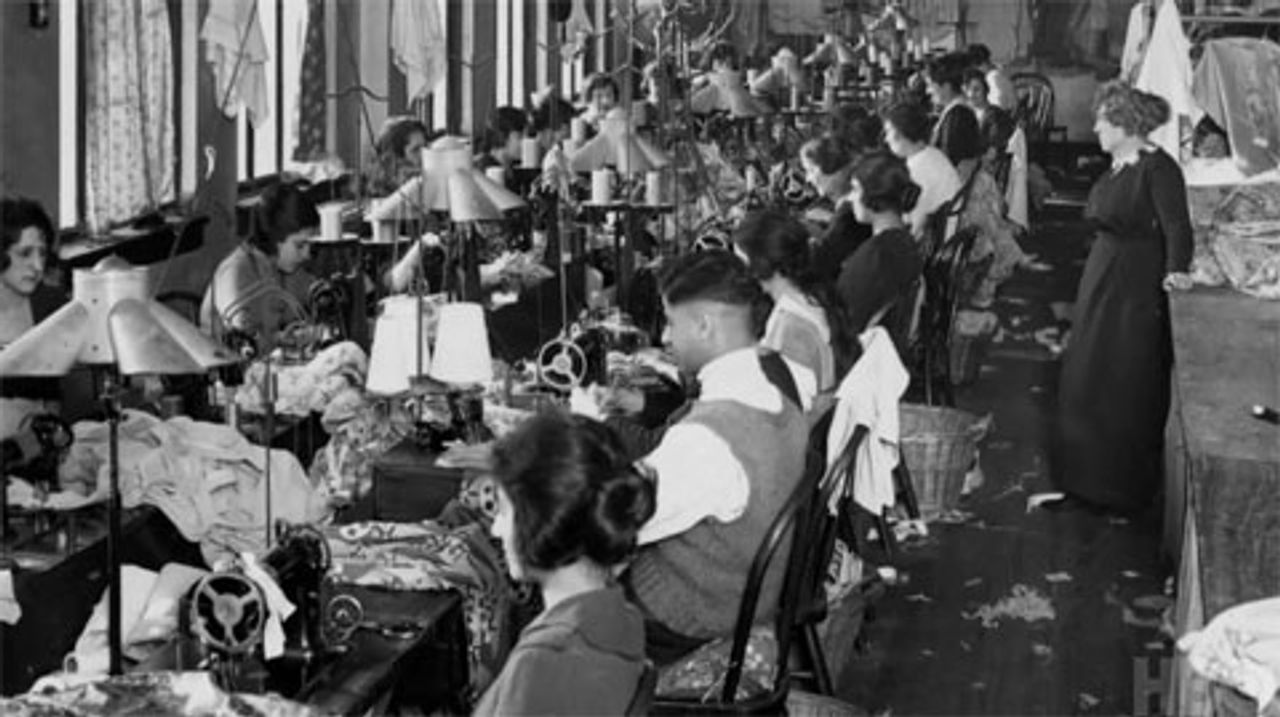March 25 marks a century since the Triangle Shirtwaist Factory fire in New York City’s Greenwich Village in which 146 workers, 122 of them women and children, either burned to death or leaped eight stories to their deaths.
 Triangle: Remember the Fire
Triangle: Remember the FireHBO’s Triangle: Remember the Fire follows the recent February 28 PBS American Experience presentation Triangle Fire in commemorating the anniversary.
Produced by Daphne Pinkerson and Mark Levin and directed by the former, Triangle: Remember the Fire features superior production qualities and a stronger narrative. The filmmakers’ limited liberal perspective is the documentary’s primary weakness.
The photographs chosen for the HBO documentary are generally of a better quality than those included in the PBS program. The photos of the victims prior to the fire, practically all of them young, smiling immigrant women, are clear and well-preserved, making the shortened lives all the more real and saddening.
Pinkerson, Levin and the production team also discovered a number of photographs of the bitter 1909 strike by thousands of women workers against the garment bosses, some of them extreme close-ups that capture strikers being beaten or thrown into paddy wagons by police and hired thugs.
More and better quality archival film footage is used in this program as well, shedding new light on the hazardous working conditions. Film of the immigrant women arriving in New York with hope on their faces is intercut with shots of cramped, brutal working conditions in the garment factories. Footage of the women--and sometimes children--at the Triangle factory surrounded by piles of the flammable material used in making shirtwaists (women’s blouses) underscores the near inevitability of the conflagration.
Most disturbing is the film of the Triangle fire itself. The firefighters, overwhelmed by flames and large billows of smoke, stand by helplessly as they stare upward at fully extended ladders unable to reach the eighth and ninth floors of the building where the women futilely awaited rescue.
The documentary’s narrative choices are also superior to those made for the American Experience production. Instead of the now commonly used faceless voices reading from letters and other writings, Triangle: Remember the Fire allows descendants of the victims help tell the story of the fire. Speaking without scripts, they mix family memories with their own feelings and conclusions, resulting in powerfully emotional vignettes that reveal the lasting nature of their hurt and anger.
One male descendent recollects reading “charred” instead of “burned” on an ancestor’s death certificate. Another of those interviewed recalls hearing his grandfather, a member of New York’s fire department, tell him that he saw “people melted together.” The granddaughter of Triangle co-owner Max Blanck is also given time. “Because he was my grandfather,” she says, “I try to understand.” But she also admits, “If I was a mother or sister of one of the victims, I’d shoot him.”
An extremely narrow perspective, however, colors the documentary’s consideration of the fire’s consequences. The immediate, personal stories are again moving. We learn that the day after the fire, relatives of victims visited the bodies for identification purposes. The remains were so disfigured and indistinguishable that one mother reportedly could recognize her child only by “the way her stockings were stitched.”
However, Triangle: Remember the Fire’s coverage of the tragedy’s legacy is another matter. The documentary does mention the trial of the Triangle Shirtwaist owners, Blanck and Isaac Harris, and their acquittal on all charges associated with the fire (which was a foregone conclusion considering the presence of Max Stoyer, a Tammany Hall lawyer, as their legal representative), but it does so in a perfunctory manner.
The documentary also notes the protests that followed, but there is not one mention of socialist presence in those protests. Given that left-wing influence among the migrant workers was pervasive and well-documented (so much so that even the PBS production was forced to mention the presence of socialists), one must conclude that the omission of this reality was deliberate, another surrender to anti-communism.
More so than was the case with the PBS production, Triangle’s conclusion is abrupt and dishonest. According to the documentary, the corrupt Tammany Hall machine and then Mayor Al Smith (who was later trounced by Herbert Hoover in the 1928 presidential election campaign) had a sudden change of heart as a result of the protests. According to this scenario, Smith and Frances Perkins (Secretary of Labor under Franklin Roosevelt and a major figure in his administration) investigated the garment factories and quickly pressed for reforms that would become part of the New Deal.
The HBO program presents Smith and Tammany Hall’s change of heart as entirely the product of seeing the miserable working conditions first-hand. What had prevented Smith and others from believing what was widely printed about the conditions in the press? Was there not, in fact, fear on the part of the authorities of the growth of anti-capitalist sentiment? The filmmakers’ argument strains credulity.
Furthermore, the documentary’s implication that between the growth of the unions and FDR’s progressive policies all working class problems were solved is preposterous, as the 21st century continues to prove.
Triangle: Remember the Fire brings the victims and the fire to life in a powerful, memorable manner. It is when the filmmakers attempt to delve into the subsequent history that their perspective fails them.
The author also recommends:
100 years since tragic blaze killed 146 garment workers
Triangle Fire on PBS’s “American Experience”: compelling documentary marred by liberal perspective
[12 March 2011]
The dawn of reformism in the US—a review of Triangle: The Fire that Changed America
[27 January 2005]
